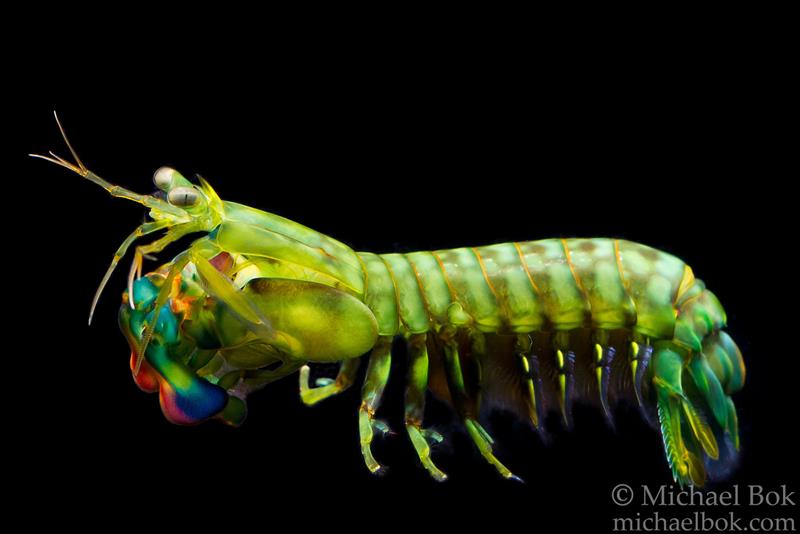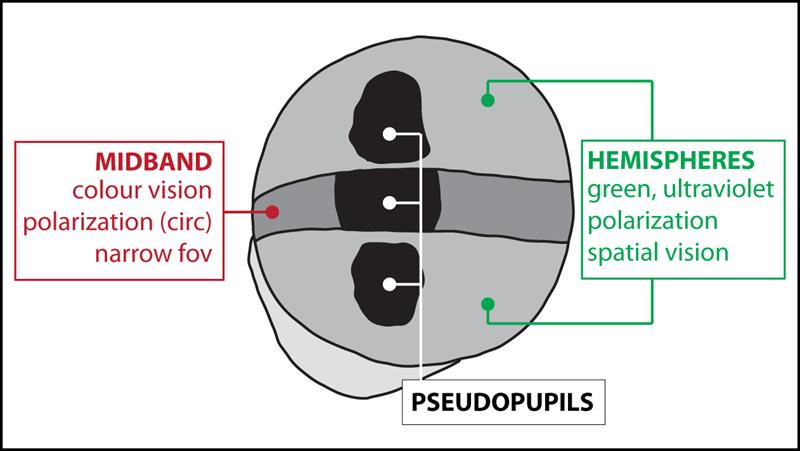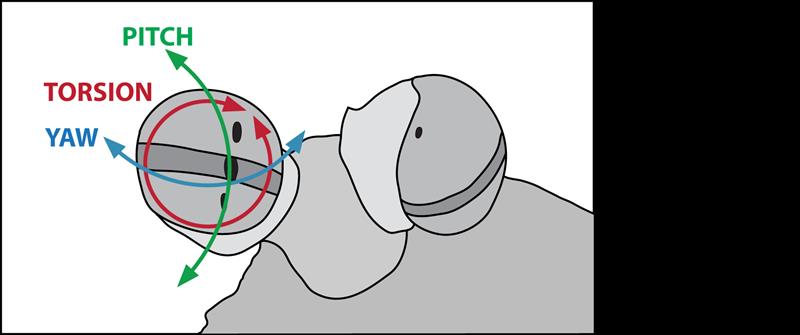
Mantis shrimp may not be the usual topic of discussion in ophthalmology, but they are living proof that there is more to the world than meets the eye. Mantis shrimp have one of the most complex visual systems on Earth. Not only do they have 12-channel colour vision, putting our three channels to shame, but they also perceive polarisation, a channel of visual information hidden from our eyes. It is fair to say that mantis shrimp see the world very, very differently from us.
Despite their name, mantis shrimp are not shrimp at all, but rather a distant relation of crabs, lobsters and other crustaceans (figure 1). They live in burrows on the sea floor and can be found in oceans across the globe, except for at the poles.
They are very brightly coloured animals with species-specific patterns (figure 2). Their body plan is incredibly complicated, with six legs, four antennas and a multitude of grasping mouthparts, two of which have evolved into ‘raptorial appendages’. As active hunters, these raptorial appendages form the basis of the mantis shrimp’s hunting strategy.
 Figure 2: There are many species of mantis shrimp, each of which has unique colouration.
Figure 2: There are many species of mantis shrimp, each of which has unique colouration.
Also known as hammers, the appendages are capable of deploying a strike with the same acceleration as a .22 calibre bullet. The mantis shrimp use them for smashing the shell of a prey animal, or knocking its legs off. Some species, rather than having hammers, have opted for spears, which they use to impale prey with the same impressive degree of acceleration. Then there are their eyes, which are the real stars of the show.
Compound eyes
Like insects, mantis shrimp have compound eyes rather than the camera-type eyes that we have. Instead of one single lens, each one of the thousands of tiny facets that make up the compound eye has its own lens, cornea and a set of photoreceptor cells. Invertebrate photoreceptors take a quite different form than human rods and cones, but the end result is the same; light is absorbed by the photoreceptor and a signal is produced, which is interpreted by the brain as vision.
Contrary to what sci-fi films would have you believe, compound eyes produce one single image rather than a mosaic of tiny, repeated images. Each facet can be thought of as a single pixel; the number of facets and their fields of view will affect the resolution of the image.
Generally, the resolution of compound eyes is fairly poor, at least by human standards, producing a blurred image. While the amount of information from such an image would be useless to us, it is perfectly sufficient for insects and crustaceans to perform all the visual tasks that they need in order to thrive.
Unusually, mantis shrimp eyes have three distinct regions, a dorsal and ventral hemisphere separated across the eye’s equator by a narrow ‘mid-band’ formed of six rows of facets (figure 3). The hemispheres are quite similar to the eyes of other crustaceans; they have blue-green and ultraviolet sensitivity along side polarisation vision.
 Figure 3: Like insects, mantis shrimp have compound eyes. However, each eye is sectioned to three parts; a dorsal and ventral hemisphere separated across the equator by the midband. The hemispheres are like regular crustacean eyes and provide the mantis shrimp with spatial vision with green and ultraviolet sensitivity plus linear polarization vision. The midband is more unusual; it consists of six rows of facets and contains all of the classes of photoreceptors for their 12-channel colour vision. However, it has an extremely narrow field of view (fov). The three dark regions are pseudo-pupils, one for each section. This is the region of the compound eye that is looking directly at the observer.
Figure 3: Like insects, mantis shrimp have compound eyes. However, each eye is sectioned to three parts; a dorsal and ventral hemisphere separated across the equator by the midband. The hemispheres are like regular crustacean eyes and provide the mantis shrimp with spatial vision with green and ultraviolet sensitivity plus linear polarization vision. The midband is more unusual; it consists of six rows of facets and contains all of the classes of photoreceptors for their 12-channel colour vision. However, it has an extremely narrow field of view (fov). The three dark regions are pseudo-pupils, one for each section. This is the region of the compound eye that is looking directly at the observer.
However, the mantis shrimp’s approach, shrinking their colour vision to a narrow 10° strip of their visual field, is highly unusual and somewhat confusing. It means that, in order to see the colour information available in a scene, they have to actively move their eyes and constantly scan their environment. No one knows why this peculiar form of colour regionalisation came about, and it is quite difficult to see what advantage it would convey to the animal.
Pitch, yaw and torsion
Given this unusual eye anatomy, it is not surprising that the eye movements mantis shrimp make are similarly complicated. The two eyes, which are on short, articulated stalks, can move independently of one another and are capable of rotation in all three degrees of freedom; pitch (up-down), yaw (side-to-side) and torsion (rotation about the eye stalk) (figure 4).
 Figure 4: Each has a >90° range of independent rotation in all degrees of freedom: pitch, yaw and torsion.
Figure 4: Each has a >90° range of independent rotation in all degrees of freedom: pitch, yaw and torsion.
So how do the eye movements of mantis shrimp compare to those that humans regularly make? Watching them for any length of time (www.youtube.com/watch?v=IpnprJ8rvuk), you get the sense that, like us, they actively investigate their environment, using their eyes in series of saccade-fixation movements that will be familiar to any clinician. Compound eyes do not have a fovea in the human sense of the word, but they can have an acute-zone, which is its equivalent, and this is the region mantis shrimp are using when they fixate. Such active, inquisitive vision is very unusual in the animal kingdom, especially among invertebrates.
Like us, mantis shrimp do need to stabilise their gaze, making compensatory eye movements to counteract the degrading effects of motion blur on their image of the world. However, it is a little more complicated than in the human visual system. When stabilising to a horizontal motion stimulus, mantis shrimp perform a very stereotypical optokinetic response. They follow the stimulus motion, closely matching its speed, for a short while before quickly counter rotating back to the original starting position and repeating the movement.
These counter rotations are so fast that vision is likely suppressed during their execution. However, even while stabilising in yaw, mantis shrimp freely rotate their eyes in pitch and torsion, which is unexpected. The whole point of gaze stabilisation is to reduce apparent motion, yet mantis shrimp apparently go out of their way to move their eyes as much as possible.
Surprisingly, the torsion rotation of the eye actually does not affect its ability to stabilise in yaw. Furthermore, there is no
evidence that mantis shrimp need to stabilise their gaze torsionally. Even humans, who have very limited torsional eye rotation, show a torsional gaze stabilisation reflex, but only by a few degrees. It would seem as though mantis shrimp have some way of processing that accounts for torsional rotation, which would make them unique.
It is quite clear that torsional rotation plays a big role in mantis shrimp vision. One of those functions is linked to their polarisation vision. Polarisation is one of the defining characteristics of light alongside colour and brightness, yet is often overlooked, probably because humans do not have polarisation vision. While colour describes the wavelength of light, polarisation is a geometric description of light waves.
Polarisation
There are a number of sources of polarisation in the natural
environment. The sky has a polarisation pattern caused by sunlight scattering from small molecules in the atmosphere. Similarly, the background illumination in shallow water (<50m) is also partially polarised due to such scattering.
Additionally, many animals have optical structures on their bodies that reflect polarised light, just as they might reflect specific colours. In terms of numbers, there are probably more animals that have polarisation sensitivity than those that do not – it just so happens that it is mostly invertebrates that do and vertebrates, like ourselves, who do not.
It is important to state here that polarisation insensitivity does not mean we cannot see polarised light; rather it means that we cannot perceive the difference between polarisation states. To our eyes, light that is polarised vertically looks exactly the same as light polarised horizontally, though a mantis shrimp could tell the difference.
Polarisation is therefore a channel of visual information that our visual system has no access to.
Mantis shrimp use polarisation information for a range of tasks including navigation, communication and contrast enhancement. It is during contrast enhancement that torsional eye movements come into play. Unlike for colour, the signal produced by a polarisation-sensitive photoreceptor depends on its orientation relative to the geometry of a light wave.
Uniquely, mantis shrimp are able to actively rotate their eyes torsionally so can alter the orientation of their photoreceptors to maximise their output signals. In other words, by torsionally rolling their eyes, mantis shrimp can improve the contrast of their polarisation vision.
The idea of rolling our eyes to improve vision is so alien to us, it is hard to comprehend, yet it explains why mantis shrimp apparently do not need to stabilise their gaze torsionally – they need to be able to see properly no matter how their eye is positioned.
Torsional rotation also has a role in colour vision. Recall that mantis shrimp can only see colour across a narrow portion of their field of view due to the photoreceptors being confined to a few rows of facets.
Consequently, in order to get colour information from an entire scene, they have to actively move their eyes using a scanning behaviour. These scans tend to happen in a direction perpendicular to the midband, which, given the torsional range of freedom, can be in any direction from vertical to horizontal.
Ongoing research
Current research is focusing on the strategies mantis shrimp employ in performing these scans. For instance, is the direction of the scan (ie orientation of the midband) dependent on the arrangement of shape and colour in the scene?
Mantis shrimp vision is nothing like our own, though a few similarities exist. They perceive a much more varied array of information that we do, including channels hidden from our eyes. While we may be closer to characterising the anatomy and movements of mantis shrimp eyes along with the neural architecture underlying their visual system, we are still a long from truly understanding them.
However, that is not to say that engineers have not been inspired by this complex eye design. New imaging systems based on mantis shrimp vision have been developed and incorporated into emerging technologies, including driverless cars, robotic platforms and hyperspectral-imaging satellites.
Dr Ilse Daly is a research associate at the School of Biological Sciences at the University of Bristol
